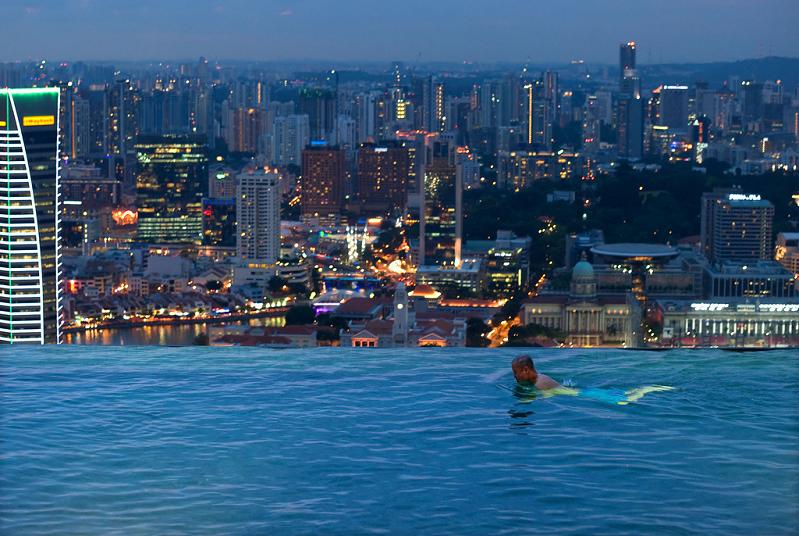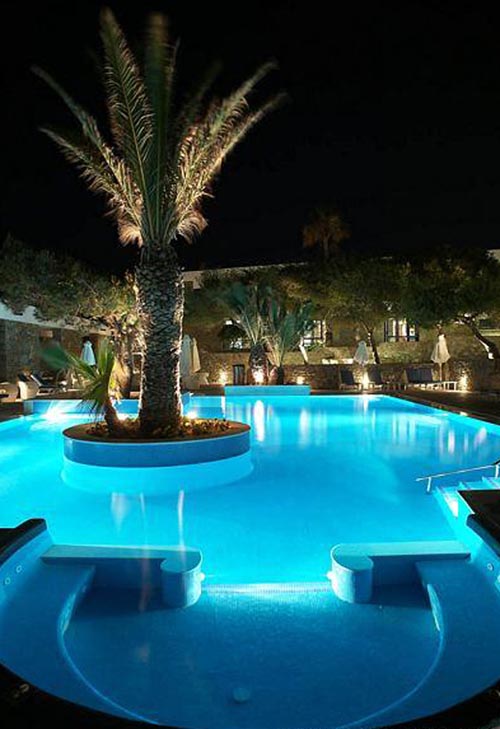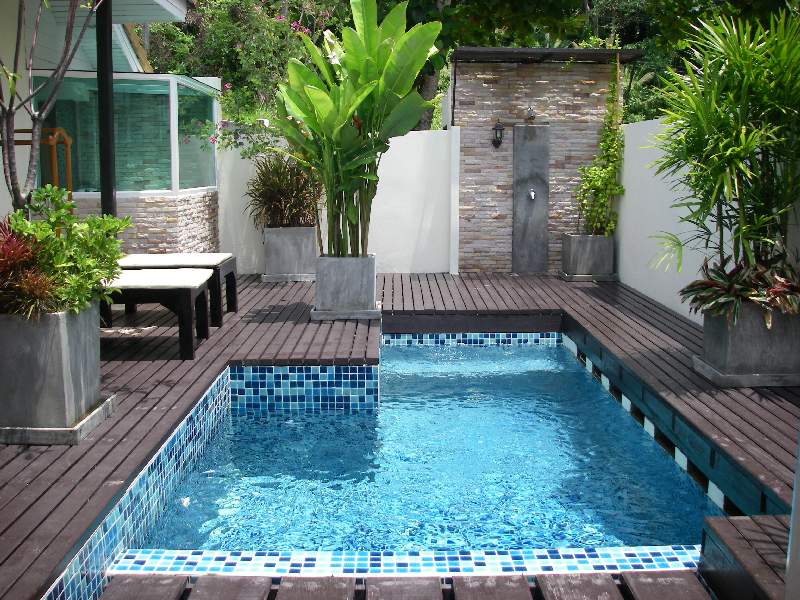
pool
An automatic swimming pool cleaner is absolutely the best piece of swimming pool equipment a pool owner can invest in. Manually cleaning a swimming pool is very time consuming and few pool owners enjoy this tedious task. An automatic swimming pool cleaner allows you to spend less time maintaining your swimming pool, and more time relaxing and enjoying your pool! There is a wide selection of automatic pool cleaners available for any budget, and every size In-Ground or Above-Ground swimming pool. There are three different types of automatic pool cleaners for In Ground pools and Above Ground pools, and they are classified by the way they collect debris and move around the pool. "Suction Side" automatic pool cleaners are connected to your pool skimmer and "Pressure Side" automatic pool cleaners connect to a return line fitting of your pool. "Robotic" pool cleaners work independently from your pool filtration system, and are powered by electricity.

pool
Suction Side automatic pool cleaners use the suction power created by your filtration system to propel a pool cleaner around your swimming pool, and pick up debris from the pool floor. Suction side automatic pool cleaners are connected to the skimmer of the pool, and dirt and debris collected from the pool is deposited directly into your filtration system. Suction side automatic pool cleaners are very easy to connect to your swimming pool and to use. These pool cleaners may have an advantage over pressure side pool cleaners, because very little or no adjustments or additional parts are typically needed to adapt a suction side pool cleaner to your swimming pool. Examples of popular suction side automatic pool cleaners are the Hayward Pool Vac or Kreepy Krauly.

pool
Pressure Side automatic pool cleaners connect to the return line fitting in the wall of your swimming pool. Pressure side automatic pool cleaners use a powerful jet of water to move around your swimming pool, and a jet of water is used to draw debris up from the pool surface into a special filter bag connected to the pool cleaner. Pressure side pool cleaners may have an advantage over suction side cleaners because they are typically more powerful and can climb the walls of an inground swimming pool. Because pressure side automatic pool cleaners are connected to the return line fitting of the swimming pool, the pool skimmer is left open to draw dirty water and debris from the surface of the pool. These pool cleaners act as a roving return line, and help eliminate "dead spots" in the swimming pool which are not reached by the circulating action of the main filter system. These pool cleaners deposit debris into a special filter bag instead of inside your pool filter system. Some pressure side pool cleaners feature their own "booster pump", which works independently from your main pool filter system to create the extra water pressure needed for these powerful cleaners. Examples of popular pressure side automatic pool cleaners are most Polaris and most Letro brand pool cleaners.

pool
Robotic automatic pool cleaners feature a built in filtration system, and operate independently from your main pool filter system. No cumbersome hoses or tedious adjustments are required. These self-contained automatic pool cleaners use on board electric motors to move around your pool and create the suction necessary to pick up debris from the pool surface. As these robotic pool cleaners move about cleaning the pool surface, they constantly circulate and filter your swimming pool water. A robotic pool cleaner will pick up debris from the pool floor, and can also climb the walls and steps of an inground swimming pool. These pool cleaners are designed to scrub the water line of the swimming pool, and regular use of a robotic swimming pool cleaner will eliminate the water line stain found on most outdoor pools.

pool
Robotic pool cleaners save a great deal of money in operating costs, because these pool cleaners do not require your pool pump and filtration system to be running for the pool cleaner to work. This also means you do not have to clean your filtration system after each use, using more electricity and losing chemically treated water through the filter backwash cycle. Robotic pool cleaners are available in many sizes and models designed for average size above ground swimming pools, up to the largest commercial facilities and water parks. Many robotic pool cleaners feature a hand held remote control, giving the pool owner complete control over the movements of the pool cleaner. This allows very quick and easy spot cleaning. The most common robotic swimming pool cleaner on the market today is the Aquabot pool cleaner.

pool
What does "Shocking" a swimming pool mean, and why is it necessary? Pool shock is a granular pool chemical, which should be added to your swimming pool at least once each week. You should shock more frequently if the pool is used heavily, after you receive large amounts of rain, or during extended periods of hot, sunny weather. The chlorine tablets or granular chlorine that you constantly dissolve into your pool water seeks out and combines with bacteria and other organics on a molecular level, to neutralize these harmful contaminants. In the process of killing these harmful contaminants the chlorine becomes inactive, and the chlorine and bacteria that have combined together is called "Combined Chlorine". The combined chlorine must be removed from the swimming pool to keep your pool water safe and clean. The combined chlorine is removed by "Shocking" the swimming pool. Super chlorinating or "Shocking" means drastically raising the chlorine level of the swimming pool for a short time, to a high enough level that the combined chlorine is oxidized and burnt off.

pool
Which Shock should you use? There seems to be a very wide selection of swimming pool shock on the market, and each pool supply distributor works hard to make their product seem a step above the rest. When all of the products are compared side by the side, the only real difference on the labels is the concentration of the active ingredients in the product. The standard pool shock that most pool owners use has the active ingredient Calcium Hypochlorite. You should expect the label to read 65% Calcium Hypochlorite. Another more concentrated version of the pool shock may have as much as 75% Calcium Hypochlorite. Some manufacturers advertise a Calcium Hypochlorite based shock product, which allows you to swim in the pool shortly after adding it. Upon examining the label you will notice that the concentration of Calcium Hypochlorite is only around 47%. Although you can swim shortly after using this type of shock product, the lower concentration of Calcium Hypochlorite may not be enough to effectively destroy bacteria and harmful contaminants in your pool. Another chlorine based shock product that most pool supply distributors offer is commonly referred to as "Lithium Shock". Rather than the active ingredient Calcium Hypochlorite that is found in common Pool Shock, Lithium Shock contains Lithium Hypochlorite. Lithium shock uses lithium as a filler instead of the calcium, which allows this product to dissolve in water much quicker and does not affect the calcium hardness level of the swimming pool. Although Lithium Shock is superior to the common Calcium Hypochlorite based pool shock, this product is not used by most pool owners due to the higher cost. In addition to the chlorine based pool shock, you will find a product called Chlorine-Free Pool Shock. This revolutionary pool chemical performs the same task of oxidizing bacteria and organics in your swimming pool water, but it does not contain chlorine or chemicals that are harsh on swimmers eyes and skin. Chlorine-Free pool shock performs just as well as a chlorine based swimming pool shock by using the active ingredient Potassium Monopersulfate. Chlorine free pool shock uses a unique chemical process to destroy bacteria, instead of raising the chlorine level of water to dangerous levels. You can actually swim in the pool only one hour after using Chlorine-Free Shock. Chlorine based pool shock (Calcium Hypochlorite) has a high pH, and will naturally raise the pH level of your swimming pool water, in addition to changing your chlorine level. Chlorine free shock has a neutral pH, and will not affect any of your pool chemical levels. Chlorine-free shock is also superior to chlorine based pool shock for normal weekly shocking because of the inert ingredients and fillers that are used in the product. Each time chlorine based (Calcium-Hypochlorite) swimming pool Shock is added to your water, you are adding calcium to the pool. This may eventually raise the calcium hardness level of the water, causing cloudiness or scaling along the water line. Chlorine based swimming pool shock should always be kept on hand, because it is the ONLY pool chemical that will kill algae after algae has grown in the pool. If your water chemistry is properly maintained, and you shock your swimming pool at least once a week, you will never see algae or experience water problems of any kind!

pool
Don't use Liquid Shock! Another type of shock that is widely available at any local pool store, hardware store and many grocery stores is liquid chlorine. This liquid chlorine is commonly used as shock, and used in place of chlorine tablets. Many pool owners believe this liquid chlorine is all they need to properly maintain a swimming pool, and unfortunately this is incorrect. Liquid chlorine is very inefficient and costly compared to properly maintaining a swimming pool using chlorine tablets and a weekly shock treatment. Liquid shock may seem easier to use than the granular shock for some pool owners because you simply walk up to the pool and dump the liquid in. The problem is that after you dump the hazardous liquid in your pool, you have to dispose of all the empty plastic bottles with the dangerous chemical residue inside. Granular pool shock is packaged in small, easy to use 1 lb. bags. If any children have access to the area where pool chemicals are stored it will be far easier to have an accident involving full or empty bottles of liquid chlorine, than an accident with bags of granular pool shock. Granular Pool Shock is rated at a minimum of 47% available chlorine and available in concentrations up to 75%. If you look at the label on a bottle of liquid chlorine it will say that it is ONLY 10% sodium Hypochlorite (chlorine)!! This means you are paying for 90% salt water with every bottle you buy. The dosage for a standard granular pool shock is 1 lb. per 10,000 gallons of pool water. If you are currently using a liquid shock, you should compare the cost of a dose of liquid shock to the cost of a dose of granular pool shock. You will find that granular pool shock can offer you a considerable savings.

pool
Instructions for "shocking" a swimming pool: Now that you know why you need to shock your pool and which pool shock product to use, the next question is how do you shock your pool. Before any pool shock is added to your swimming pool water the chemical must first be pre-dissolved in a bucket of water. All forms of pool shock are granular, and should dissolve relatively quickly. The first step is to fill a 5-gallon bucket with water from the pool and slowly pour the granular pool shock into the bucket of water (NEVER add water to a chemical, always add chemicals to water). Stir the bucket well and agitate the water for one minute or more to dissolve the pool shock. With the filtration system running, slowly pour the bucket of dissolved shock directly in front of the return line fitting. You will see the dissolved shock water being carried out into the pool by the jet of water coming from the return line. Pour slow enough that all of the water pouring from the bucket is carried out into the pool, and does not settle to the pool floor. When you near the bottom of the bucket (down to about 1/4 left in the bucket) you should fill the bucket back up with pool water and stir it again for one minute or more. There will be shock granules at the bottom of the bucket, which did not dissolve the first time. If you have a vinyl liner in your swimming pool you cannot allow un-dissolved pool shock to settle to the floor, because this may bleach or stain your pool liner.

pool
Pool pH & Pool Alkalinity The pH and Alkalinity levels of swimming pool water affect many areas of the swimming pool and must be kept at the correct levels if you expect to successfully maintain your swimming pool. The Alkalinity of pool water acts as a buffer for the pH, and helps prevent the pool pH level from fluctuating. The Alkalinity should be maintained at 80 - 120 ppm. The pH is the measure of the acidity of the swimming pool water, and the pH level should be maintained at 7.2 - 7.6 ppm. The pH of pool water is somewhat sensitive, but easily controlled if the Alkalinity is kept in range. All basic pool test kits should read the pH and Alkalinity level of pool water, and these levels are easily adjusted with common water balancing pool chemicals. If the pool pH level is not kept in range pool water may irritate the skin and eyes of swimmers, corrode the pool surface and inside of the pool equipment and make it very hard to maintain the chlorine level of the swimming pool.

pool
Pool Chlorine Stabilizer The chemical name of pool "Stabilizer" is Cyanuric Acid and it is referred to by either title. The Stabilizer level of swimming pool water must be maintained at 30-50 ppm. The Stabilizer level is important, but is typically only tested at the beginning of the swimming season when a pool is opened. The Stabilizer in swimming pool water partially surrounds the chlorine on a molecular level, to protect the chlorine and prevent the chlorine from being quickly burned off and used up by the sun. The symptoms of having too much Stabilizer or too little stabilizer in your pool water are very similar, and if you experience problems maintaining a chlorine level when all other chemical levels are properly balanced the stabilizer level should be tested. If the Stabilizer level tests lower than 30 ppm it will be difficult to maintain a chlorine level, because any chlorine added to your swimming pool will quickly evaporate and burn off in direct sunlight. If the Stabilizer level tests above 50 ppm it will also be difficult to maintain a chlorine level. Rather than partially surrounding the chlorine in your pool water to protect the chlorine, too much stabilizer will completely surround the chlorine making it inactive. In this state the chlorine is unable to combine with bacteria and harmful contaminants to sanitize your swimming pool. Stabilizer can be added to a swimming pool if necessary to raise the level, however once Stabilizer is present in pool water it cannot be easily removed. To reduce the amount of Stabilizer in a swimming pool the water must be diluted by partially draining the pool and re-filling with fresh water. 25% of the pool water should be drained and replaced with fresh water. The pool should be circulated for 12-24 hours, and the Stabilizer level should be tested again. This process should be repeated until the Stabilizer level is within range. The chlorine tablets and granular chlorine used to sanitize a swimming pool on a daily basis is a pre-stabilized form of chlorine. This means that the chlorine contains a small amount of stabilizer, and as chlorine is added to the pool a very small amount of Stabilizer is also added to help maintain the level. This small amount of Stabilizer constantly added with pool chlorine does not cause a problem in outdoor swimming pools because water is splashed out or evaporates, and gets replaced with fresh water to dilute the Stabilizer. This pre-stabilized form of chlorine cannot be used in indoor swimming pools, because much less water evaporation occurs and the stabilizer level will slowly buildup. Indoor swimming pool owners need to use an un-stabilized form of chlorine.

pool
Calcium Hardness The calcium hardness of swimming pool water refers to the amount of the mineral calcium present in the pool water. The calcium hardness should be maintained at 80-150 ppm in a pool with a vinyl liner, or 150-200 ppm in a concrete or plaster finish pool. Low levels of calcium hardness can lead to corrosive water conditions, which may damage the pool surface, pool equipment and pool plumbing. If the water in a plaster or masonry finish pool becomes corrosive, the water will absorb calcium from the pool walls and floor by eating away at the pool surface until the hardness level nears 150 ppm. The calcium hardness level can be easily raised using a Calcium Hardness Increaser available from most pool supply dealers. High levels of calcium hardness may lead to cloudy pool water and "scaling". Scaling is most visible around the water line of a swimming pool as a white chalky deposit, but also forms inside pool equipment and pool plumbing. A pool Calcium Hardness Reducer chemical is available from most pool supply companies to lower the hardness to the desired range for your pool. You may also partially drain and refill a swimming pool with fresh water, which has a lower concentration of Calcium. Calcium is present in the water used to fill the pool and in the pool chemicals used to treat the water. The pool chemical that adds the most calcium to pool water is standard chlorine pool shock. If you find that your calcium hardness level is too high, read the label of the pool shock you've been using and you will likely find that the active ingredient is calcium hypochlorite. Each time this pool shock is added to the pool water, calcium is added to the water. To prevent this problem begin using Chlorine-Free Pool Shock on a regular basis, instead of standard chlorine pool shock (Calcium Hypochlorite). The active ingredient in chlorine-free pool shock is Potassium Monopersulfate, which does the same job of oxidizing bacteria and harmful organics but does not contain any calcium. If you choose to switch to chlorine-free shock you should always still keep the standard chlorine pool shock on hand, because it is the only pool chemical capable of killing algae.

pool
Installing a new vinyl liner for your pool is fast and easy and takes very little technical skill. Installing the liner is actually quite easy in terms of a DIY project especially considering how much money you can save over the course of one weekend. Being a commercial vinyl pool liner installer is a more difficult process since you will need to be required to have knowledge outside of what it takes to install the liner itself, and are held accountable for each liner installation to be cosmetically perfect.

pool
Installing three liners per week without any wrinkles or problems requires years of experience in the trade. Installing a single liner, in your own pool, for the expressed benefit of saving thousands of dollars is easy by comparison. The most likely problem that you can encounter when installing your own liner is to have wrinkles on the floor and slopes. Even if the liner is sized well you can still easily have wrinkles in your liner if you do not have the ability to diagnose the problem and adjust the liner accordingly. A professional installer uses experience to orient the liner for the best fit possible where you will just wing it based upon what you see at the time. In a worst case scenario you are not able to lose all the wrinkles and have to live with the results. The real benefit here is that as long as you are satisfied with the results, then the project was successful since wrinkles are cosmetic and do not compromise the pools ability to hold water.

pool
Owning your own pool is beyond the wildest dreams of most people. Many rumours exist about the cost of installing and running a swimming pool. In practice most people don't really have much idea about what's involved in setting up and running a swimming pool until they actually own one. In recent years, the introduction of a large range of PVC based above ground pools has brought the ownership of a swimming pool within reach of many more consumers.






























0 comments:
Post a Comment